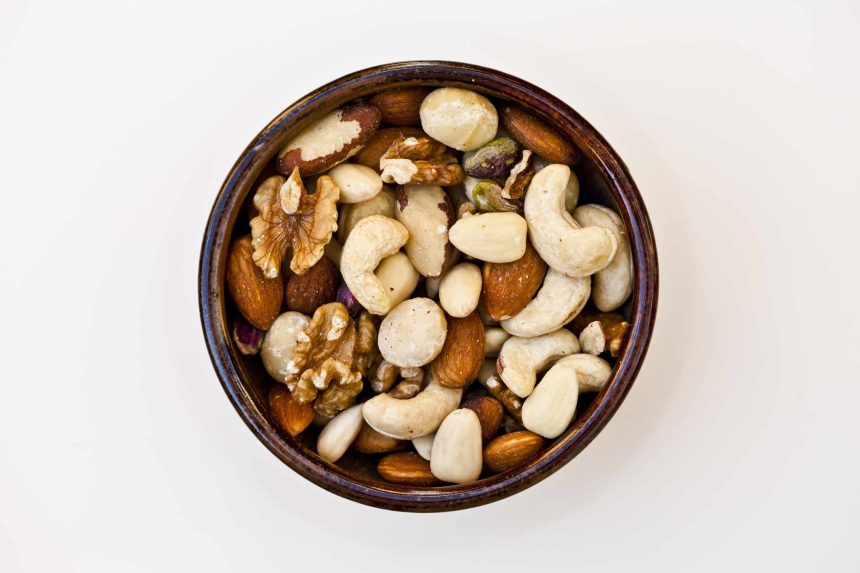Nuts are packed with plant-based protein, healthy fats, and key nutrients like potassium, magnesium, and vitamin E. They’re a great snack to help prevent energy dips and mood swings throughout the day. If you’re working on hitting a daily protein goal, like the recommended 0.8 grams per kilogram of body weight, consider adding these nuts to your diet.
jirkaejc / Getty Images
Protein content: 7.31 grams per ounce, or 14.6% of the Daily Value (DV)
Like other legumes, peanuts are high in protein. Peanuts are rich in mono- and polyunsaturated fats and provide many antioxidant nutrients, including phenolic acids, phytosterols, and resveratrol, which can help manage your blood pressure and cholesterol levels.
Pakin Songmor / Getty Images
Protein content: 6.01 grams per ounce, or 12% of the DV
Almonds boast a balanced mix of macronutrients (proteins, fats, and carbohydrates). Rich in essential vitamins and minerals, almonds may help protect against diabetes, obesity, and heart disease.
alvarez / Getty Images
Protein content: 5.73 grams per ounce, or 11.5% of the DV
Pistachios, which are 21% protein, have a distinct earthy flavor that can enhance both savory and sweet dishes. These nuts contain all nine essential amino acids—the building blocks of proteins—making them a complete protein source. They can help you feel full, support digestion, and help manage blood pressure.
Westend61 / Getty Images
Protein content: 5.16 grams per ounce, or 10.3% of the DV
Cashews have a subtle flavor and rich, creamy texture when blended, making cashew milk an excellent vegan, high-protein alternative to dairy. The nuts are a good source of potassium and magnesium, which play a role in blood pressure control and overall heart health.
The overall nutrient composition of cashews makes them a heart-healthy alternative to saturated fatty acid-rich foods like butter and heavy cream.
Aksenovko / Getty Images
Protein content: 4.31 grams per ounce, or 8.6% of the DV
Walnuts are not only high in protein, but unique among nuts for mainly containing polyunsaturated fats. This included an omega-3 fatty acid called alpha lipoic acid (ALA), which offers anti-inflammatory effects.
Research suggests the nutritional composition of walnuts may help reduce the risk of age-related brain disorders, such as Alzheimer’s disease.
ligora / Getty Images
Protein content: 4.25 grams per ounce, or 8.5% of the DV
Hazelnuts are both protein-heavy and a rich source of anti-inflammatory monounsaturated fatty acids (MUFAs), which may help improve cholesterol levels. Some research suggests that while hazelnuts are high in fat, consuming them doesn’t necessarily lead to weight gain. That’s because the nut’s potent antioxidants help inhibit inflammation and oxidative damage.
Eugenia Lucasenco / Getty Images
Protein content: 4.01 grams per ounce, or 8% of the DV
Just one Brazil nut (5 grams) contains about 95.8 micrograms of selenium, approximately 175% of the DV. Selenium has been linked to potential cancer-reducing properties. High doses of selenium can be toxic, with the upper limit set at 400 micrograms per day. For this reason, experts advise limiting your intake to no more than three Brazil nuts per day (about half an ounce).
Mizina / Getty Images
Protein content: 3.88 grams per ounce, or 7.8% of the DV
Pine nuts offer a distinct light crunch and a rich, buttery flavor. They are commonly used to make pesto. Pine nuts consist of about 20% protein and 60% fat due to their high oil content. Most of their fats are polyunsaturated fatty acids (PUFAs), including alpha-linolenic acid (ALA), a plant-based source of heart-healthy omega-3 fatty acids.
Daniela Duncan / Getty Images
Protein content: 2.6 grams per ounce, or 5.2% of the DV
Pecans are often popular in autumn, featuring in dishes like turkey stuffing and pecan pies. These nuts deliver nearly 3 grams of protein per ounce and are rich in polyunsaturated fats, which may benefit heart health. Pecans also contain tannins, antioxidant nutrients that may help reduce harmful bacteria.
fcafotodigital / Getty Images
Protein content: 2.24 grams per ounce, or 4.5% of the DV
Macadamia nuts are unique because three-quarters of their calories come from fat, primarily MUFAs. Of these MUFAs, about 80% is oleic acid, which regulates antioxidant activity and promotes immune function. Macadamia nuts are one of the few foods that contain palmitoleic acid (another MUFA), which may help reduce adiposity, a severe state of obesity.
Nuts are incredibly versatile and can incorporated into your diet as smoothie ingredients, trail mix combinations, and oatmeal toppers. Here are some other delicious ways to enjoy them in your diet:
- Nut-crusted chicken or fish: Instead of breadcrumbs, use crushed nuts (almonds and walnuts are good options) to coat your chicken or fish before baking.
- Nutty grain salad or bowl: Start with brown rice and quinoa, add crunchy veggies like carrots and celery, and toss in some chopped toasted walnuts.
- Nut and seed bars or protein bites: Whether you prefer a round bite or a bar, it’s easy to whip up a nut and seed protein mixture. A simple recipe includes oats, nut butter, maple syrup, and a combination of your preferred chopped nuts and seeds.
- Parfait topping: Add a sprinkle of crunchy seasoned pistachios to your yogurt and berry parfait.
- Chocolate-dipped Brazil nuts: Melt dark chocolate chips in the microwave, heating in 15-second intervals until smooth. Dip two Brazil nuts until completely coated, then place them on a small plate lined with wax paper. Let them cool in the refrigerator until the chocolate sets.
High-protein nuts are a great choice for curbing hunger and sustaining your energy levels. Among these nuts, peanuts lead with an impressive 7.31 grams of protein per ounce, while pistachios—ranking third—provide all nine essential amino acids.






